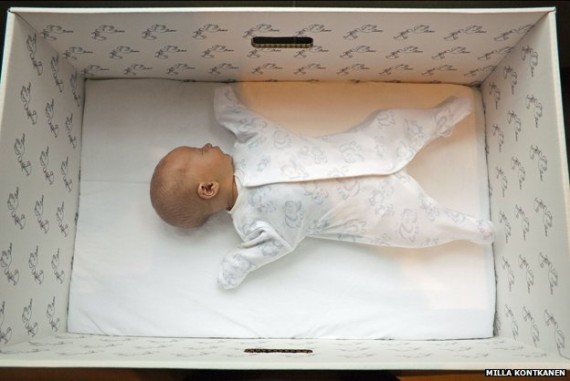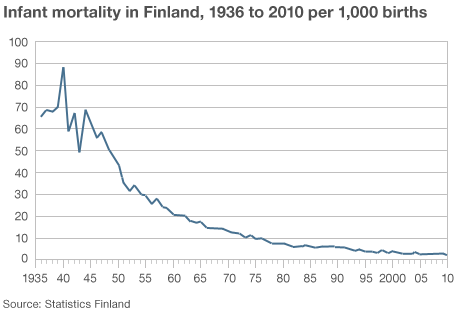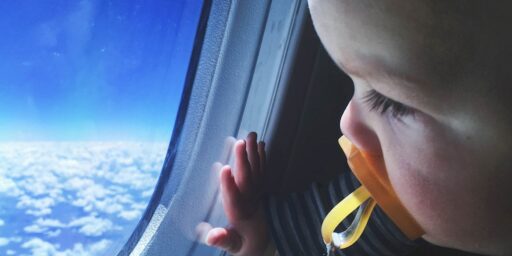Finland’s Cardboard Baby Boxes
Finland gives all parents of newborns a cardboard box for their babies to sleep in. No, they're not homeless.
Finland gives all parents of newborns a cardboard box for their babies to sleep in. No, they’re not homeless.
BBC (“Why Finnish babies sleep in cardboard boxes“):
For 75 years, Finland’s expectant mothers have been given a box by the state. It’s like a starter kit of clothes, sheets and toys that can even be used as a bed. And some say it helped Finland achieve one of the world’s lowest infant mortality rates.
It’s a tradition that dates back to the 1930s and it’s designed to give all children in Finland, no matter what background they’re from, an equal start in life.
The maternity package – a gift from the government – is available to all expectant mothers.
It contains bodysuits, a sleeping bag, outdoor gear, bathing products for the baby, as well as nappies, bedding and a small mattress.
With the mattress in the bottom, the box becomes a baby’s first bed. Many children, from all social backgrounds, have their first naps within the safety of the box’s four cardboard walls.
Mothers have a choice between taking the box, or a cash grant, currently set at 140 euros, but 95% opt for the box as it’s worth much more.
The tradition dates back to 1938. To begin with, the scheme was only available to families on low incomes, but that changed in 1949.
“Not only was it offered to all mothers-to-be but new legislation meant in order to get the grant, or maternity box, they had to visit a doctor or municipal pre-natal clinic before their fourth month of pregnancy,” says Heidi Liesivesi, who works at Kela – the Social Insurance Institution of Finland.
So the box provided mothers with what they needed to look after their baby, but it also helped steer pregnant women into the arms of the doctors and nurses of Finland’s nascent welfare state.
In the 1930s Finland was a poor country and infant mortality was high – 65 out of 1,000 babies died. But the figures improved rapidly in the decades that followed.
So, what’s in the box?
- Mattress, mattress cover, undersheet, duvet cover, blanket, sleeping bag/quilt
- Box itself doubles as a crib
- Snowsuit, hat, insulated mittens and booties
- Light hooded suit and knitted overalls
- Socks and mittens, knitted hat and balaclava
- Bodysuits, romper suits and leggings in unisex colours and patterns
- Hooded bath towel, nail scissors, hairbrush, toothbrush, bath thermometer, nappy cream, wash cloth
- Cloth nappy set and muslin squares
- Picture book and teething toy
- Bra pads, condoms
So, basically, a baby starter kit and a baby stopper kit. Interestingly, no baby formula, which we got with both our babies despite intentions to breastfeed.
For some families, the contents of the box would be unaffordable if they were not free of charge, though for Vayrynen, it was more a question of saving time than money.
She was working long hours when pregnant with her first child, and was glad to be spared the effort of comparing prices and going out shopping.
“There was a recent report saying that Finnish mums are the happiest in the world, and the box was one thing that came to my mind. We are very well taken care of, even now when some public services have been cut down a little,” she says.
When she had her second boy, Ilmari, Vayrynen opted for the cash grant instead of the box and just re-used the clothes worn by her first, Aarni.
A boy can pass on clothes to a girl too, and vice versa, because the colours are deliberately gender-neutral.
This is pretty genius. And, while surely not the only or even the most important factor, this trend line is amazing:
Not a bad investment, I’d say.








I strongly suspect that most of the graph is explained by antibiotics and immunizations.
As a comparison consider the decline in the infant mortality rate in Scotland since the late 1930s. There’s a similar sharp decline.
The US currently has an infant mortality rate that’s 2.78 times that in Finland.
The invisible hand is strangling babies.
@Dave Schuler:
And, in a related manner, increasing wealth. Finland in the 1930 was a very poor and backwards country; large swathes of the population didn’t even have indoor plumbing or running water at home.
Much of Northern Europe turned against the use of baby formula a while ago. Plus that particular industry had never taken a particularly strong hold there. That isn’t happening any time soon around here — the formula industry has way too much of a foothold, especially in communities of color.
I’m far more struck by the inclusion of condoms in the kit. Is that something along the lines of “now that you realized the big mistake you made, let’s be sure not to do it again?”
@Dave Schuler:
Indeed. I’m working on what is essentially a campaign to reduce infant mortality in the developing world. Nearly every country in which we are working has a similar decline starting a decade ago. Example, cote d’ivoire:
http://www.indexmundi.com/g/g.aspx?c=iv&v=29
@PJ:
The US also has a much higher teen/single mother birth rate than much of the developed world, which is obviously a major contributing factor when it comes to infant mortality
@PJ:
Infant mortality is closely correlated with low birth weight which is, in turn, closely correlated with drug and alcohol use during pregnancy. I don’t have the figures at hand to back me up but I suspect that the level of drug and alcohol use during pregnancy is higher here than in Finland and that accounts for much of the difference in infant mortality between the two countries.
This report from the NIH considering the demographics of drug and alcohol use during pregnancy within the United States makes interesting reading.
@Doug Mataconis:
The best response I can give to that, Doug, is that it’s complicated. Distribution of low birth weight babies by maternal age, correlated with infant mortality, is U-shaped, with mothers younger than 15 and older than 40 being at highest risk.
I don’t know of evidence that single motherhood in the absence of other factors, e.g. drug and alcohol use during pregnancy, maternal age, socio-economic status, etc., is correlated with infant mortality. I’d certainly be interested in corroborative information.
@Dave Schuler: @Rafer Janders: Oh, certainly. I think this package helps new parents–especially young, poor ones–make it through the early weeks. But the contribution to lowered mortality is likely at the margins.
@Matt Bernius: Indeed. It’s a pretty good nudge toward family planning.
@Dave Schuler: What’s interesting is that, in my circles, pregnant women either simply don’t drink alcohol or they do so only in private, given the stigma associated. In Europe, women continue to drink wine and consider the whole thing silly. But, yes, I suspect we have more heavy drinking and drug use during pregnancy in the lower classes than in Europe.
@Doug Mataconis:
Proof that abstinence-only campaigns work!
Can you imagine if a democrat, or worse, Obama, proposed something like this here? The Republican media would be full of cries of “Baby Killers!”
@James Joyner:
It’s not predominately the “lower classes” here either. I’d bet a Chardonnay is nearly as likely as a 40 Oz. in many cases.
There’s not a whole lot of evidence that alcohol affects the baby until you get up to something resembling 15 drinks per week! But the American medical society errs on the very cautious side, basically saying there haven’t been enough studies yet, therefore NO DRINK IS SAFE AND YOU’RE A BAD MOM IF YOU EVEN LOOK AT A BOTTLE.
By the way, I think this box would be even more effective if they guaranteed the mattress didn’t include cancer-causing fire retardants like most American ones do.
@MarkedMan: More likely they’d just claim “you’re copying ideas from socialists, you socialist!”
@PJ:
The US also use a much stricter definition of infant mortality than most countries. Under federal law, if any infant draws so much as a single breath and subsequently dies, that’s considered an infant death. In most countries, any infant under 500g who dies quickly is considered stillborn. And those countries generally don’t go for intense neonatal ICU intervention.
If you look at the US’s infant mortality rate, you’ll see a similar decline. From about 55 in the 1930’s to about 5-6 today.
Interesting, if you had a crappy mother, you didn’t get this leg up. Seems to me a better stick would be that the mother had to visit the clinic before 4 months or the cash option wasn’t available.
But here in the US, private companies/charities are better situated for this although it needs more coordination. Last thing you want in your life is a child welfare agent of the state. Besides Target, et al, know when a girl is pregnant long before most people close to them
@James Joyner:
Maternal drug or alcohol use does not appear to be strictly a socioeconomic phenomenon in the United States. As the paper I linked above suggests, there appear to be significant differences among various racial and ethnic groups independent of family income. I would characterize the issue as cultural rather than class.
@MarkedMan: For GOP support of the government paying for it one’d have to pack the box with bibles (King James of course), toss the rubbers in the trash and deliver the box directly to the fetus in vivo.
Interesting from the timeline at the article.
1957 – the went from cloth and sewing material to ready=made clothes.
got to keep up with the times and talents
Plus, seems even Finland isn’t safe from the baby nazis.
@Hal 10000:
In 2009 there were 1.97 stillbirths per 1000 births in Finland, in the same year, there were 2.95 stillbirths per 1000 births in the US. So, Finland has a third less stillbirths/1000 births than the US despite having a less strict definition of infant mortality…
I think that most of Europe and Japan, Australia, New Zealand, etc, the countries the US should be compared to, do intense neonatal ICU interventions….
Agree, most countries have had that decline, the issue here being that in the US it stops declining at 5-6. Compare that with countries like Slovenia and the Czech Republic, which both had higher infant mortality rates than the US 20-30 years ago, but now have rates like Finland.
@Matt Bernius:
I am assuming you meant this in jest, no?
I know here in Canada they are quite adamant at telling you after birth to not get pregnant right away due to the havoc on the body. In my area condoms can be gotten free at any Health Clinic, and even the Mac’s store in the town my son goes to school in has a bowl set up for anyone to take them (altho, as my son told me, “Never trust a condom from a Mac’s – they explode”. Seems he, and his buds, being teen boys and all, took some back to the school and in gym class decided to fill them with water from the showers. Needless to say, they were not very resilient…)
I remember too, when I had my daughter 19 years ago, all first-time moms received something similar. It was a package including diapers, bathing accessories, tin of formula, etc. Mind you, we didn’t have the pleasure of the box/crib… ;-}
@PJ:
The disparity is significantly less. it’s also not clear to be what definition the WHO is using in that regard since some countries do not count stillbirths before a certain age or weight. In the US, any death after the 20th week is considered stillborn or infant mortality. Some countries still count those as miscarriages.
That having been said, the US stillbirth rate is significantly better than the infant mortality rate. We rank 34th in infant mortality but 17 in still birth. And that’s a bit deceptive because the rate are essentially within the noise from about rank 5 to rank 35.
@Dave Schuler:
You’re right, but you have to appreciate this was part of the reason for the box in the first place: it creates a very significant incentive for young mothers to visit pediatric care clinics that are found all over Finland. To get a box free, a prospective mother has to go and get her first ante-natal checkup before she is 4-months pregnant. Considering the value of the items in the box, as well as how it has become a cultural touchstone for Finns, almost all future mothers in Finland receive excellent pre-natal care.
American women are catching on to this Finnish trend. Perhaps our own government should look into a program like this that can be combined with WIC. Instead of giving them cash assistance they can get what they really need. I know a lot of mothers out there that do not use the cash for their infant like they are supposed to.
http://www.allvoices.com/contributed-news/14778381-finnish-babies-sleep-in-cardboard-boxes-us-women-catch-on
I think the box provided by the government is amazing. What a positive way to support the arrival of a new citizen!! Along with its contents, the box (what a great first bed for baby) and the staples for a newborn is a wonderful social benefit and public health initiative (condoms and all) for everyone involved.